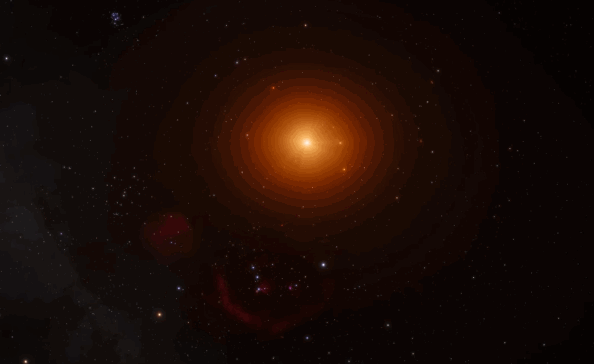A tiny star just 39 light years away, a mere stone's throw in cosmic terms, hosts seven Earth-sized planets, according to new research published in Nature. At least six of them appear to be rocky and temperate. Some could potentially have liquid water at the surface, and by extension, the right ingredients for life."This is the first time that so many planets of this kind are found around the same star," said lead author Michaël Gillon, astronomer at the Université de Liège, who spoke to reporters in advance of the public announcement on Tuesday. "Looking for life elsewhere, this system is probably our best bet as of today," said co-author Brice-Olivier Demory, at the University of Bern, in a release that accompanied the news.
Advertisement
An infographic showing how the seven planets at TRAPPIST-1 might appear, alongside rocky planets in our own solar system. Image: NASA
The newly discovered solar system has some significant differences to our own. Its host star, TRAPPIST-1, is what's called an "ultracool" red dwarf. It's only about eight percent of the mass of our Sun, and 11 percent of its radius. The seven planets orbit very snugly around this star: all are found within the distance of Mercury's orbit.Most are tidally locked, so that one side always faces the star, while the other has a perpetual nighttime. (The researchers compared it to the Galilean moons of Jupiter, which are also tidally locked with their host planet.)When scientists are trying to identify the potential habitability of an exoplanet (any planet outside our own solar system), they look for a few qualities, including the energy output from its host star, and its orbital distance. This helps scientists determine whether its surface temperature stays within a relatively temperate range of 0 and 100℃, so liquid water could exist.
An artist's illustration of the TRAPPIST-1 system. Image: NASA
According to Gillon, this solar system seems to have some very promising candidates. Despite the planets being so close to the star, TRAPPIST-1 is "so small and cold [that the planets] are temperate, which means that they could have liquid water on the surface," he said.The planets' mass measurements, while preliminary, indicate they are likely rocky, another promising sign for habitability. (No life forms that we know of could survive on a gas giant like Jupiter.) It was also determined that the star isn't very active, and that large solar flares are rare, yet another factor that makes these planets look like they could be friendly to life.
Advertisement
Because this solar system is relatively close to Earth, scientists have already been able to glean hints about some of the planets' atmospheres. Further study will only give them more clues to habitability. Remarkably, the planets are just about ideal for future observation, the scientists noted to reporters. Since the star emits most of its energy as infrared light, the James Webb Space Telescope—which makes its observations in the infrared spectrum—will be perfect for studying details of these newfound planets when it launches in 2018."It's true such a star is very faint in the optical [light], but this signature we're searching for, you can find it in the infrared," said Gillon.
An artist's impression of the view from a planet in the TRAPPIST-1 system. Image: ESO/M. Kornmesser/spaceengine.org
Scientists are hopeful that future missions (including the JWST) would be able to detect ozone in any of the potential atmospheres, which could be an indicator of biological activity.The TRAPPIST-1 star is named for the robotic telescope project that was used to discover it. TRAPPIST (it stands for TRansiting Planets and PlanetesImals Small Telescope) uses transit photometry to detect planets in other star systems. That means TRAPPIST analyses the dip in the light of the host star when a planet swings in front of it.

Remotely controlled by staff in Belgium, the first stage of the telescope system was built in the mountains of Chile at the La Silla Observatory. Now, with new hardware added in Morocco, its observation range has been expanded. "We have access to the whole sky, north and south to look for these planets," said Emmanuël Jehin, co-author of the study.
Advertisement
The TRAPPIST team's discoveries were supported by European Southern Observatory's Very Large Telescope, and observatories in the Canary Islands and South Africa.Read More: We're Getting A Lot Better at Looking for Habitable PlanetsThe TRAPPIST-1 star system also made headlines last year with the announcement of three orbiting exoplanets. Upon further observation, a rare triple transit was detected, suggesting that there were more worlds, beyond just those three, to discover.
Our own Sun compared to TRAPPIST-1, which is much smaller and redder in colour. Image: ESO
As for actually visiting these planets, for the foreseeable future that will be impossible (although the system would make an interesting target for Project Starshot, an initiative to pioneer interstellar travel). If humanity ever does manage to make it that far, according to study co-author Amaury Triaud, the space voyagers would see a sky with a crimson or "salmony" sun."The spectacle would be beautiful, because every now and then you would see another planet maybe about twice as big as the Moon, depending on which planet you're on and which planet you look at," said Triaud. Maybe one day.Get six of our favorite Motherboard stories every day by signing up for our newsletter.
